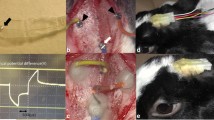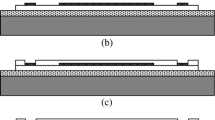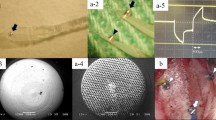Abstract
Background
A new method of stimulating the retina electrically, called suprachoroidal transretinal stimulation (STS), was shown to be effective in eliciting electrically evoked cortical potentials (EEPs) in Royal College of Surgeons (RCS) rats. Before extending this technique to patients, it is important to determine its safety and feasibility in eliciting EEPs from medium-size animal (rabbits). The purpose of this study was to determine the safety and efficacy of the surgical procedures used to implant an multichannel electrode array into a scleral pocket, and to determine whether the implanted electrodes can stimulate the retina effectively.
Methods
These acute experiments were conducted on six rabbits. An array of eight gold microelectrodes, embedded in polyimide, was implanted into a scleral pocket over the visual streak area. The size of the microarray was 2×4×0.180 mm. The reference electrode was implanted into the vitreous. The electrode array and reference electrodes were connected to a stimulator to deliver monophasic current pulses. Cortical responses were recorded with a stainless steel electrode implanted into each rabbit’s skull over the visual cortex. After the experiment, the eyes and electrodes were examined histologically.
Results
The surgical procedures for electrode implantation were accomplished without serious complications. EEPs were recorded after monophasic electrical pulse stimulation from each electrode. The mean threshold for EEPs was 55.0±10.0 μA with a 0.5-ms duration inward current pulse. The charge delivered at threshold was about 27.5 nC, and the charge density was about 56.0 μC/cm2. Histopathological examination of the retinal tissue around the area of stimulation did not show damage at the light microscope level with the electrical parameters used.
Conclusions
Our technique for STS with an intrascleral microelectrode array is safe in rabbit eyes, and EEPs were elicited by current densities that did not induce tissue damage. These results suggest that STS via intrascleral multichannel electrodes is a feasible method for stimulating the retina.







Similar content being viewed by others
References
Choudhury DP (1978) Visual field representation in the newborn rabbit’s cortex. Brain Res 153:27–37
Chow AY, Chow VY (1997) Subretinal electrical stimulation of the rabbit retina. Neurosci Lett 225:13–16
Chow AY, Pardue MT, Perlman JI, Ball SL, Chow VY, Helting JR, Peyman GA, Liang C, Stubbs EB Jr, Peachey NS (2002) Subretinal implantation of semiconductor-based photodiodes: durability of novel implant designs. J Rehabil Res Dev 39:313–322
Dawson WW, Radtke ND (1977) The electrical stimulation of the retina by indwelling electrodes. Invest Ophthalmol Vis Sci 16:249–252
Eckmiller R (1997) Learning retina implants with epiretinal contacts. Ophthalmic Res 29:281–289
Humayun MS, Probst R, de Juan E Jr, McCormick K, Hickingbotham D (1994) Bipolar surface electrical stimulation of the vertebrate retina. Arch Ophthalmol 114:40–46
Humayun MS (2001) Intraocular retinal prosthesis. Trans Am Ophthalmol Soc 99:271–300
Inoue J, Potts AM (1971) Electrically evoked response of the visual system (EER) in the rabbit. Nippon Ganka Gakkai Zasshi 20(75):765–772
Kanda H, Morimoto T, Fujikado T, Tano Y, Fukuda Y, Sawai H (2004) Electrophysiological studies on the feasibility of suprachoroidal–transretinal stimulation for artificial vision in normal and RCS rats. Invest Ophthalmol Vis Sci 45:560–566
Majji AB, Humayun MS, Weiland JD, Suzuki S, D’anna SA, de Juan E Jr (1999) Long-term histological and electrophysiological results of an inactive epiretinal electrode array implantation in dogs. Invest Ophthalmol Vis Sci 40:2073–2081
Margalit E, Maia M, Weiland JD, Greenberg RJ, Fujii GY, Torres G, Piyathaisere DV, O’Hearn TM, Liu W, Lazzi G, Dagnelie G, Scribner DA, de Juan E Jr, Humayun MS (2002) Retinal prosthesis for the blind. Surv Ophthalmol 47:335–356
McCreery DB, Agnew WF, Yuen TG, Bullara L (1990) Charge density and charge per phase as cofactors in neural injury induced by electrical stimulation. IEEE Trans Biomed Eng 37:996–1001
Nadig MN (1999) Development of a silicon retinal implant: cortical evoked potentials following focal stimulation of the rabbit retina with light and electricity. Clin Neurophysiol 110:1545–1553
Schwahn HN, Gekeler F, Kohler K, Kobuch K, Sachs HG, Schulmeyer F, Jakob W, Gabel VP, Zrenner E (2001) Studies on the feasibility of a subretinal visual prosthesis: data from Yucatan micropig and rabbit. Graefes Arch Clin Exp Ophthalmol 239:961–967
Walter P, Szurman P, Viobig M, Berk H, Ludtke-Handjery H-C, Deng HR, Mittermayer C, Heimann K, Sellhaus B (1999) Successful long term implantation of electrically inactive epiretinal microelectrode arrays in rabbits. Retina 19:546–552
Walter P, Heimann K (2000) Evoked cortical potential after electrical stimulation of the inner retina in rabbits. Graefes Arch Clin Exp Ophthalmol 238:315–318
Zrenner E, Stett A, Weiss S, Aramant RB, Guenther E, Kohler K, Miliczek KD, Seiler MJ, Haemmerle H (1999) Can subretinal microphotodiodes successfully replace degenerated photoreceptors? Vision Res 39:2555–2567
Zrenner E (2002) Will retinal implants restore vision? Science 295:1022–1025
This study was supported by Health Science Grant, Japan, and by a grant (No. 14571670) from the Ministry of Education, Culture, Sports, Science and Technology, Japan.
Author information
Authors and Affiliations
Corresponding author
Additional information
H.K., T.Y., and S.N. are employees of NIDEK Co.
Rights and permissions
About this article
Cite this article
Nakauchi, K., Fujikado, T., Kanda, H. et al. Transretinal electrical stimulation by an intrascleral multichannel electrode array in rabbit eyes. Graefe's Arch Clin Exp Ophthalmol 243, 169–174 (2005). https://doi.org/10.1007/s00417-004-1060-2
Received:
Revised:
Accepted:
Published:
Issue Date:
DOI: https://doi.org/10.1007/s00417-004-1060-2




